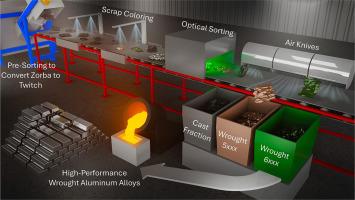混合消费后铝废料流的合金选择性光学分选
IF 10.9
1区 环境科学与生态学
Q1 ENGINEERING, ENVIRONMENTAL
引用次数: 0
摘要
粉碎后的消费铝废料流含有混合的铸造和锻造铝片非常不同的成分,导致下降循环的混合废料成非结构铸造铝合金和零件。本文介绍了一种合金族废旧铝片彩色编码的化学处理方法,并演示了低成本的铸件和锻件的光学分选,以改善废旧铝片流。色差启用>;95%的纯度在光学分类铸造和锻造部分。我们还根据合金系列(如5xxx和6xxx)对锻造铝片和废料进行了着色,这有可能创建一个循环供应链,在这个供应链中,锻造铝合金从混合废料流中分类,并回收到高价值的锻造产品。我们的TEA和LCA显示了我们的着色方法和光学分选的可行性,我们讨论了对美国铝和运输行业的影响。本文章由计算机程序翻译,如有差异,请以英文原文为准。

Alloy selective optical sorting of mixed post-consumer aluminum scrap streams
Shredded post-consumer aluminum scrap streams contain a mixture of cast and wrought aluminum pieces with very different compositions, resulting in downcycling of the mixed scrap into non-structural cast aluminum alloys and parts. In this paper, we introduce a chemical treatment method to color-code scrap aluminum pieces by alloy family and demonstrate low-cost optical sorting of cast from wrought pieces to upgrade the scrap stream. The color difference enabled > 95 % purity in the optically sorted cast and wrought fractions. We also colored wrought aluminum pieces and scrap by alloy families, such as 5xxx and 6xxx, which has the potential to create a circular supply chain in which wrought aluminum alloys are sorted from the mixed scrap stream and recycled back to high-value wrought products. Our TEA and LCA show feasibility of our coloring method and optical sorting, and we discuss the implications for the U.S. aluminum and transportation industries.
求助全文
通过发布文献求助,成功后即可免费获取论文全文。
去求助
来源期刊

Resources Conservation and Recycling
环境科学-工程:环境
CiteScore
22.90
自引率
6.10%
发文量
625
审稿时长
23 days
期刊介绍:
The journal Resources, Conservation & Recycling welcomes contributions from research, which consider sustainable management and conservation of resources. The journal prioritizes understanding the transformation processes crucial for transitioning toward more sustainable production and consumption systems. It highlights technological, economic, institutional, and policy aspects related to specific resource management practices such as conservation, recycling, and resource substitution, as well as broader strategies like improving resource productivity and restructuring production and consumption patterns.
Contributions may address regional, national, or international scales and can range from individual resources or technologies to entire sectors or systems. Authors are encouraged to explore scientific and methodological issues alongside practical, environmental, and economic implications. However, manuscripts focusing solely on laboratory experiments without discussing their broader implications will not be considered for publication in the journal.
 求助内容:
求助内容: 应助结果提醒方式:
应助结果提醒方式:


